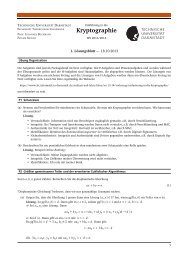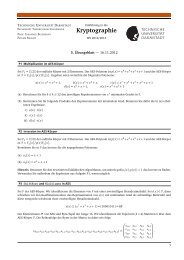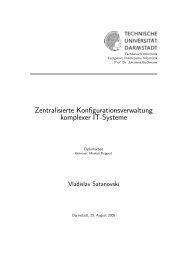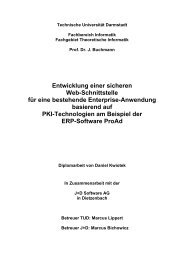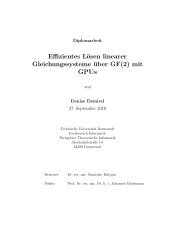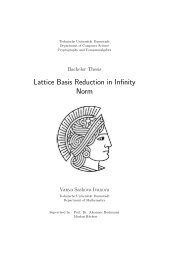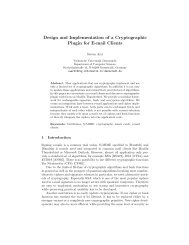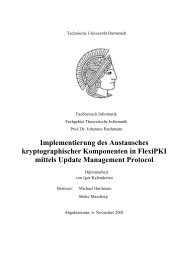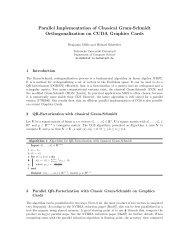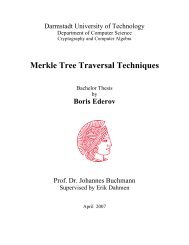An efficient mobile PACE implementation - CDC
An efficient mobile PACE implementation - CDC
An efficient mobile PACE implementation - CDC
You also want an ePaper? Increase the reach of your titles
YUMPU automatically turns print PDFs into web optimized ePapers that Google loves.
4.1 Rearranging Equations<br />
When rearranging the equations we have to regard the following<br />
facts: X must be sent to the PICC in order to receive Y , and therefore<br />
it must be computed before H, G ′ , � P KPCD and K. � P KPCD<br />
must be sent to the PICC in order to receive � P KPICC and therefore<br />
it must be computed before K. In addition to Equation (3), G ′<br />
is needed in the last <strong>PACE</strong> step (j), because it is part of the input<br />
for the computation of TP CD. Thus, G ′ should be a result or be<br />
computable from the result without increasing the overall computational<br />
cost. We consider the following possibilities for merging<br />
the equations.<br />
α: Standard Interleaving.<br />
One possible optimization is to merge Equations (2) and (3) as<br />
shown in Equation (6) to compute G ′ using interleaved multiplication.<br />
X, � P KPCD, and K are computed as shown in Equations<br />
(1), (4), and (5). This leads to an overall computation cost of 3<br />
MULT and 1 PSUM. Using the best available algorithm and parameters,<br />
w-NAF Interleaving with w = 5, PSUM needs 78 ADD<br />
and 258 DBL (cf. Table 6). This is a vast improvement compared<br />
to 2 MULT evaluated as sequential single point w-NAF multiplications,<br />
which sum up to 78 ADD and 386 DBL (according to Table<br />
2). A possible shortcoming is that s, which is only half the length<br />
of x, is forced into a scalar multiplication of the dimension of the<br />
size of x.<br />
G ′ = s · G + x · Y (6)<br />
β: Short Scalar Interleaving.<br />
The shortcoming of the above Equation (6) regarding the interleaved<br />
multiplication with s and x may be countered using the following<br />
trick: We know that the size of s is half the size of x. We<br />
break the pair (x, Y ) into two pairs (x1, Y1) and (x2, Y2) as is<br />
done when using the Lim-Lee method. The scalars x1, x2, and s<br />
now have the same size and the pair (s, G) can be added as third<br />
summand to the pairs (x1, Y1) and (x2, Y2) resulting in a standard<br />
interleaved multiplication with three summands as shown in Equation<br />
(7). As with Equation (6), X, � P KPCD, and K are computed<br />
as shown in Equations (1), (4), and (5). This leads to an overall<br />
computation cost of 3 MULT and 1 PSUM where the scalars in the<br />
PSUM are half the size of those of the PSUM of Equation (6). Using<br />
w-NAF Interleaving with w = 5 PSUM needs 85 ADD and 131<br />
DBL according to Table 7 and additionally 128 DBL to prepare Y2.<br />
In total this is nearly the same as the PSUM costs resulting from<br />
Equation (6) and thus, is also a vast improvement compared to the<br />
not optimized version.<br />
G ′ = s · G + x1 · Y1 + x2 · Y2 (7)<br />
γ: Inversion.<br />
A third possibility is to merge Equations (2), (3), and (4) as<br />
shown in Equation (8) to compute � P KPCD using interleaved multiplication.<br />
G ′ then has to be computed by a scalar multiplication<br />
with an inverse as shown in Equation (9). X and K are computed<br />
as shown in Equations (1) and (5). This also leads to an overall<br />
computation cost of 3 MULT and 1 PSUM. w-NAF Interleaving<br />
leads to a cost of 99 ADD and 258 DBL (see Table 6). The necessary<br />
inversion and multiplications of scalars modulo the order r<br />
of the elliptic curve are neglectable in comparison to the operations<br />
on the points. A possible shortcoming is that the optimization potential<br />
of having an s of half the size of all other involved scalars is<br />
given away by multiplying it with a full size scalar. A possible ad-<br />
vantage of this approach is that the computation of G ′ , which is not<br />
needed again until the last step of <strong>PACE</strong> is reached, can be delayed<br />
until then.<br />
�P KPCD = ( � SKPCD · s) · G + ( � SKPCD · x) · Y (8)<br />
G ′ = ( � SK −1<br />
PCD mod r) · � P KPCD<br />
δ: Splitted Inversion.<br />
<strong>An</strong> also promising possibility to calculate � P KPCD is to reuse<br />
the precalculated points of G (see also Section 4.3) and evaluate<br />
Equation (10) with the Lim-Lee method. <strong>An</strong>other advantage of<br />
this method is the possibility to start the calculation of Equation<br />
(10) right after evaluating the first equation of the <strong>PACE</strong> algorithm<br />
(cf. Figure 1). Assumed the precomputed points or Lim-Lee multiplication<br />
are available, the evaluation of Equation (10) leads to 51<br />
ADD and 25 DBL (cf. Table 4). The evaluation of Equation (11)<br />
results to 50 Add and 257 DBL (cf. Table 1). In total the Equations<br />
(10) to (12) that replace the PSUM in approach γ lead to 102 ADD<br />
and 282 DBL.<br />
(9)<br />
�P K1 = ( � SKPCD · s) · G (10)<br />
�P K2 = ( � SKPCD · x) · Y (11)<br />
�P KPCD = � P K1 + � P K2 (12)<br />
G ′ = ( � SK −1<br />
PCD mod r) · � P KPCD<br />
(13)<br />
4.2 Tweaked Implementation<br />
As seen above significant improvements are possible by applying<br />
well chosen multiplication algorithms and by rearranging the<br />
equations to be solved. However, there are possibilities for improvement<br />
concerning the <strong>implementation</strong> itself. In the following<br />
we consider possibilities to speed up the protocol execution taking<br />
into account at which points dedicated results have to be available<br />
and by avoiding overhead due to <strong>implementation</strong> techniques. Note<br />
that the optimizations are presented in a Java ME specific way, but<br />
can be applied to other languages analogously.<br />
Reorganization.<br />
<strong>An</strong>other possibility to speed up the calculations is the reorganization<br />
of their order. We present two different kinds of reorganizations.<br />
One possibility is to put some calculations at the beginning of<br />
the protocol before the initial contact with the eID card. To do so<br />
we need the domain-parameters of the used eID card saved on our<br />
device. These parameters can be stored at the first contact and can<br />
be used henceforward. The generation of the private keys x and<br />
�SKPCD as well as the computation of the first ephemeral key X<br />
(Equation (1)) could be done before actually starting the protocol.<br />
Additionally multiples of the base-point G could be stored in the<br />
NVM and later reused within the point multiplications. However,<br />
this is currently not supported by the existing Java ME-libraries.<br />
<strong>An</strong>other kind of reorganization regards the scheduling of the<br />
tasks and calculations during the protocol. Using threads for<br />
communication with the eID card allows us to use the time waiting<br />
for an answer from the card or the user for further calculations.<br />
The decryption of s can be threaded for instance, since the result<br />
will be required later in step (e) (cf. Figure 1).





